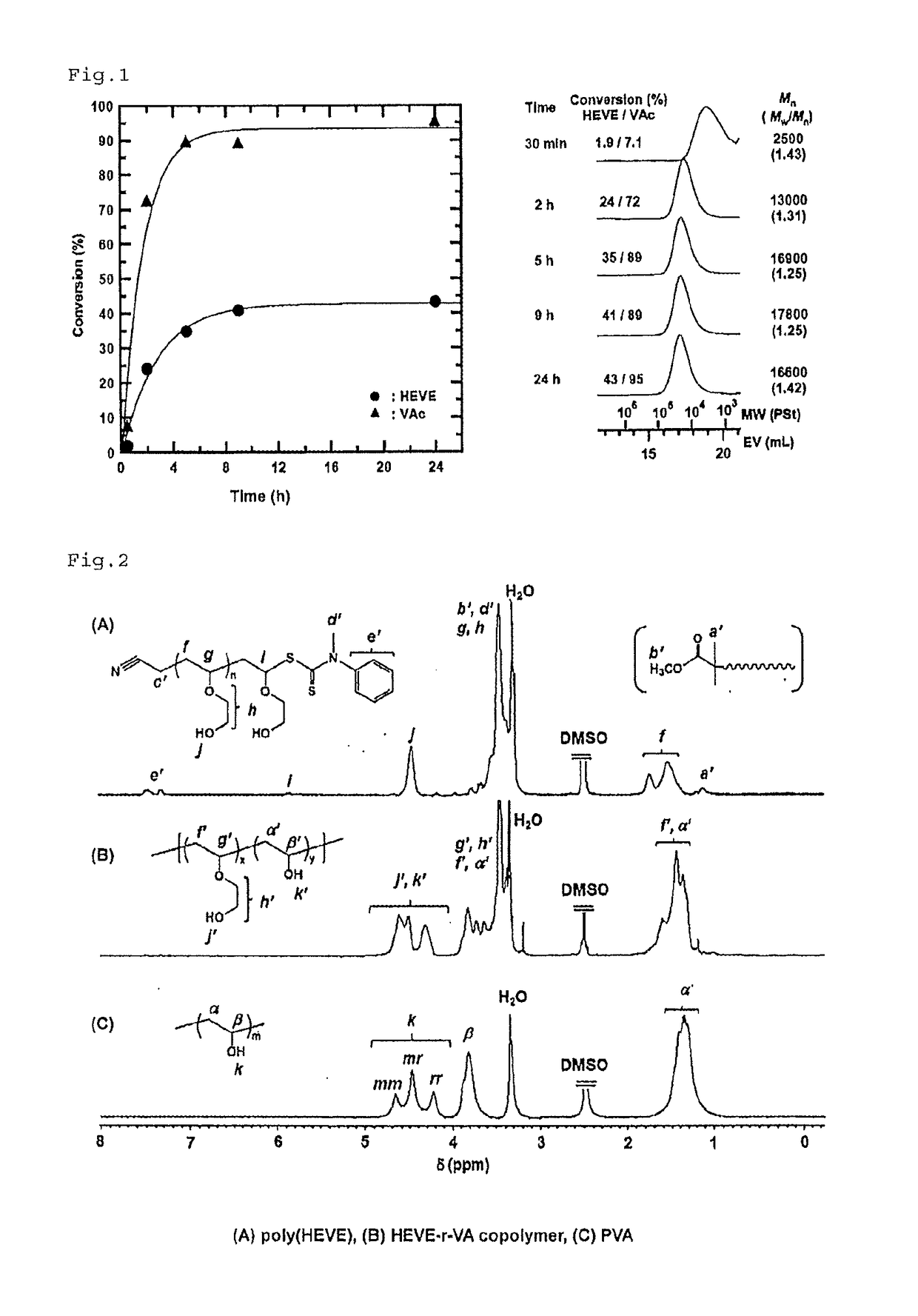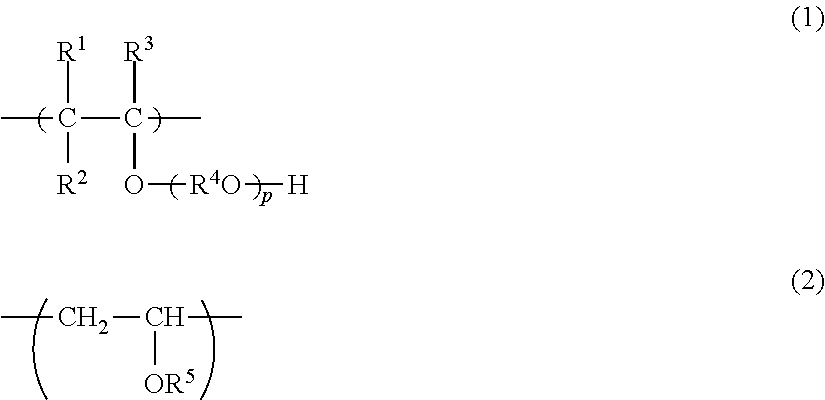Alkenyl ether-vinyl ester copolymer
a technology of alkenyl ether and ester, which is applied in the field of alkenyl ethervinyl ester copolymer, can solve the problems of difficult to apply the homopolymer to a medical material that utilizes temperature responsiveness around body temperature, difficult to apply the polymer to a medical material, etc., and achieves excellent biocompatibility and easy synthesizing
- Summary
- Abstract
- Description
- Claims
- Application Information
AI Technical Summary
Benefits of technology
Problems solved by technology
Method used
Image
Examples
example 1
Synthesis Example of (HEVE-r-VAc) Random Copolymer (1)
Radical Bulk Polymerization
[0076]2.22 3 g (25.5 mmol) of 2-hydroxyethyl vinyl ether (hereinafter referred to as “HEVE”), 1.777 g (20.64 mmol) of vinyl acetate (hereinafter referred to as “VAc”), and 0.021 g (0.032 mmol) of dimethyl 2,2′-azobis (2-methylpropionate; (V-601, a trade name, produced by Wako Pure Chemical Industries, Ltd., hereinafter referred to as “V-601”) as a radical polymerization initiator were added to a test tube and sufficiently dissolved (HEVE / VAc=55 / 45, monomer / V-601=500 / 1). Subsequently, a stirring bar was added to the test tube, and nitrogen was blown into the test tube in an ice bath for deoxygenation. After the deoxygenation, the test tube was sealed, and radical bulk, polymerization was performed in an oil bath at 70° C. Radical bulk polymerization was also performed in the same manner as above except that HEVE / VAc was changed to 59 / 41, 60 / 40, 62 / 36, 65 / 35, 67 / 33, and 70 / 30.
[0077]For the resulting copol...
example 2
Synthesis Example of (HEVE-r-VAc) Random Copolymer (2)
RAFT Polymerization
[0079]2.56 g (29 mmol) of HEVE, 2.5 g (2.9 mmol) of VAc, 0.027 g (0.11 mmol) of V-601 as a radical polymerization initiator, and 0.0645 g (0.29 mmol) of S-cyanomethyl-N-methyl-M-phenylcarbamodithioate (produced by Sigma-Aldrich Corporation) as a RAFT agent were added to a test tube and sufficiently dissolved (HEVE / VAc=100 / 100, CMPCD / V-601=5 / 2). Subsequently, a stirring bar was added to the test tube, and nitrogen was blown into the test tube in an ice bath for deoxygenation. After the deoxygenation, the test tube was sealed, and RAFT polymerization was performed in an oil bath at 70° C.
[0080]After elapsing an arbitrary polymerization time, a part of the reaction solution was drawn, and the monomer conversion, and the number average molecular weight Mn and the molecular weight distribution Mw / Mn of the polymer were obtained by the GPC analysis and the NMR analysis. As a result, after elapsing 24 hours, the monom...
example 3
Synthesis Example of (HEVE-r-VAc) Random Copolymer (3)
RAFT Polymerization
[0081]RAFT polymerization was performed in the same manner as in Example 2 except that the charge concentration of the monomers was changed to HEVE / VAc=1 / 2. After elapsing 24 hours, the monomer conversion was 52% for HEVE and 92% for VAc, and the resulting polymer had a number average molecular weight Mn of 32,200 and a molecular weight distribution Mw / Mn of 1.21. The ratio HEVE / Vac was 22 / 78.
PUM
| Property | Measurement | Unit |
|---|---|---|
| Temperature | aaaaa | aaaaa |
| Temperature | aaaaa | aaaaa |
| Critical solution temperature | aaaaa | aaaaa |
Abstract
Description
Claims
Application Information
 Login to View More
Login to View More - R&D Engineer
- R&D Manager
- IP Professional
- Industry Leading Data Capabilities
- Powerful AI technology
- Patent DNA Extraction
Browse by: Latest US Patents, China's latest patents, Technical Efficacy Thesaurus, Application Domain, Technology Topic, Popular Technical Reports.
© 2024 PatSnap. All rights reserved.Legal|Privacy policy|Modern Slavery Act Transparency Statement|Sitemap|About US| Contact US: help@patsnap.com










